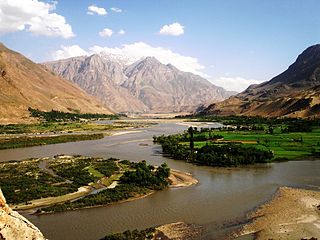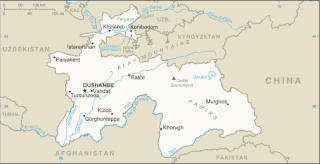Related Research Articles

Tajikistan, officially the Republic of Tajikistan, is a landlocked country in Central Asia. It has an area of 143,100 km2 (55,300 sq mi) and an estimated population of 9,749,625 people. Its capital and largest city is Dushanbe. It is bordered by Afghanistan to the south, Uzbekistan to the west, Kyrgyzstan to the north, and China to the east. It is separated narrowly from Pakistan by Afghanistan's Wakhan Corridor. The traditional homelands of the Tajiks include present-day Tajikistan as well as parts of Afghanistan and Uzbekistan.

The Armed Forces of the Republic of Tajikistan, also known as the Tajik National Army is the national military of the Republic of Tajikistan. It consists of Ground Forces, Mobile Forces, and the Air Force, with closely affiliated forces including the national guard, border and internal troops.

Dushanbe is the capital and largest city of Tajikistan. As of January 2020, Dushanbe had a population of 863,400 and that population was largely Tajik. Until 1929, the city was known in Russian as Dyushambe, and from 1929 to 1961 as Stalinabad, after Joseph Stalin. Dushanbe is located in the Gissar Valley, bounded by the Gissar Range in the north and east and the Babatag, Aktau, Rangontau and Karatau mountains in the south, and has an elevation of 750–930 m. The city is divided into four districts, all named after historical figures: Ismail Samani, Avicenna, Ferdowsi, and Shah Mansur.

Tajik, also called Tajiki Persian or Tajiki, is the variety of Persian spoken in Tajikistan and Uzbekistan by Tajiks. It is closely related to neighbouring Dari with which it forms a continuum of mutually intelligible varieties of the Persian language. Several scholars consider Tajik as a dialectal variety of Persian rather than a language on its own. The popularity of this conception of Tajik as a variety of Persian was such that, during the period in which Tajik intellectuals were trying to establish Tajik as a language separate from Persian, prominent intellectual Sadriddin Ayni counterargued that Tajik was not a "bastardised dialect" of Persian. The issue of whether Tajik and Persian are to be considered two dialects of a single language or two discrete languages has political sides to it.

The culture of Tajikistan has developed over several thousand years. Tajik culture can be divided into two areas, Metropolitan and Kuhiston (Highland). Modern city centres include Dushanbe, Khudjand, Kulob, and Panjikent.

Khujand, sometimes spelled Khodjent and known as Leninabad from 1936 to 1991, is the second-largest city of Tajikistan and the capital of Tajikistan's northernmost Sughd province.

Bukhara Region is a region of Uzbekistan located in the southwest of the country. The Kyzyl Kum desert takes up a large portion of its territory. It borders Turkmenistan, Navoiy Region, Qashqadaryo Region, a small part of the Xorazm Region, and the Karakalpakstan Republic. It covers an area of 40,216 km2. The population is estimated at 1,976,823 (2022), with 63% living in rural areas.

Shighnan, also Shignan, Shugnan, Shughnan, and Khughnan, is an historic region whose name today may also refer to a town and a district in Badakhshan Province in the mountainous northeast of Afghanistan and also a district in Gorno-Badakhshan Autonomous Province in Tajikistan. The administrative center of the Shighnan District of Afghanistan is called Qaleh Barpanjeh. The administrative center of the Shughnon District of Tajikistan is called Khorogh.

Human rights in Tajikistan, a country in Central Asia, have become an issue of international concern. The access to basic human rights remains limited, with corruption in the government and the systematic abuse of the human rights of its citizens slowing down the progress of democratic and social reform in the country.
Colonel Mahmud Khudoiberdiyev was a rebel leader in Tajikistan who, while initially an ally of Tajik President Emomali Rahmon, became an opposition figure later on in his life. He is a former member of the Central Committee of the Tajik Communist Party and a former major in the Soviet Army. He also served as commander of the Tajik Army's First Brigade.

The Uzbekistan–Tajikistan border minefields are the result of Uzbekistan's unilateral decision to indiscriminately mine rural areas along its border region with Tajikistan. This action is aimed at hindering drug trafficking and cross-border infiltrations of terrorists of the Islamic Movement of Uzbekistan, but the mines have caused many civilian casualties. Uzbekistan asserted that it is placing mines in its territory, but so far not all the boundaries between Uzbekistan and Tajikistan have been delineated. By 2004 Tajikistan and Uzbekistan had settled almost 86% of their 1,283-km border dispute following the collapse of the Soviet Union in 1991. In 2018, the new Uzbekistan President Shavkat Mirziyoyev promised in an agreement with Tajikistan to de-mine the border. As of January 2020, reports emerged in Tajik media claiming that the de-mining was completed on the border.
In parallel to what happened in other Soviet republics, a cinema of Tajikistan was promoted by the Soviet state, and declined in the first years after the independence, before being revitalized through the efforts of the new government.
Takhir Sabirov is a Tajik film director, actor, screenwriter, art director, and one of the most notable figures of the Tajik cinema. He is known as the "founding father" of the One Thousand and One Nights dynasty of the film industry due to his creation of the Scheherazade trilogy.

Corruption in Tajikistan is a widespread phenomenon that is found in all spheres of Tajik society. The situation is essentially similar to that in the other former Soviet republics of Central Asia. Reliable specifics about corruption can be difficult to come by, however, as can hard information about the effectiveness of supposed anti-corruption initiatives.

The Afghanistan–Tajikistan border is 1,357 km (843 mi) in length and runs from the tripoint with Uzbekistan in the west to the tripoint with China in the east, almost entirely along the Amu Darya, Pyanj and Pamir rivers, except for the easternmost section along the Wakhan Corridor.

Kamil Yarmatov was a prominent actor and director in the cinema of Tajikistan during the Soviet era. He later moved to Uzbekistan and then to Moscow.

The COVID-19 pandemic in Tajikistan is part of the worldwide pandemic of coronavirus disease 2019 caused by severe acute respiratory syndrome coronavirus 2. The virus was confirmed to have spread to Tajikistan when its index cases, in Dushanbe and Khujand, were confirmed on 30 April 2020.

A three-day border conflict between Kyrgyzstan and Tajikistan began on 28 April 2021. The clashes stemmed from a long-running dispute over a water supply facility near the village of Kök-Tash. Tajik media raised some concern over military drills in Batken prior to the conflict.
This is a list of individuals and events related to Kyrgyzstan in 2022.

A series of sporadic border clashes resumed between Kyrgyzstan and Tajikistan on 27 January 2022, following a series of clashes in 2021 between the two countries.
References
- ↑ "True Noon BF-2010". International Film Festival Rotterdam. Retrieved 7 April 2013.
- ↑ Bakker, Niels (May 2010). "True noon en Mundane history". Filmthuis (in Dutch).
- ↑ ""True Noon," when politics destroys the lives of citizens". Festival International du film de Marrakech. Retrieved 7 April 2013.
- ↑ Умарзода, Фируз (June 5, 2012). Н. Саидов: "Главное - сценарий, а деньги найдутся". ASIA-Plus (in Russian). Dushanbe.
- ↑ van Egmond, Meinte. "True Noon – Qiyami roz (2009)". Cinemagazine (in Dutch).